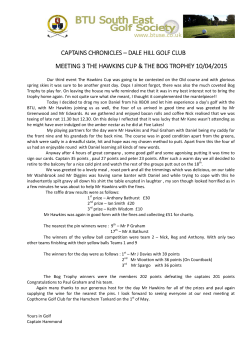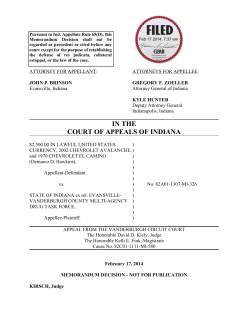
How to Brief a Case Hawkins v. McGee
How to Brief a Case Hawkins v. McGee Why brief a case? For your use Prepare you for class Prepare you for finals Components of a Case Brief Court and Date Parties Relief Requested Legal Theories Used Procedural History Facts Issue(s) Holdings/Dicta Reasoning/Rationale/Rule Date and Court Citation: The style of the case is the name of the case. For example, in the case where George Hawkins sued Edward McGee the case name is . . . Hawkins v. McGee Note that the case is styled using the last name of the party from each side. Date and Court Citation: It can be important to know which court decided a case and when the case was decided. Is it a Federal or State case ? In it in the Appellate court of last resort ? How old is the case? (see handout for sample cite) Reading Case Citations Smith v. Jones, 123 F.2d 456 (2d Cir. 1989) parties’ names volume book page no. court & date Cat. v. Bat, 123 U.S. 456,460 (1977). Hawkins v. McGee, 146 A. 641 (N.H. 1929) Parties Who is the plaintiff ? Who is the Defendant ? Is there anything about their relationship that effects the legal analysis or outcome of the case? (i.e. governmental employee) Relief Requested/ Legal Theories Used What do the parties want to happen? Money, injunction, summary judgment? What is the theory for recovery ? (i.e. negligence, breach of contract) You may want to write down whether the case was criminal or civil. Procedural posture: How did the case get to this court ? What were the legal claims and what happened in the lower court. Identify what happened in prior proceedings first, then present proceedings. Stages in a Civil Case The Complaint Discovery Trial-Directed Verdict Appeal Answer Verdict(motions) (J.N.O.V./New trial) Pretrial (Jury Selection/Charge) The Facts Section The facts section describes the events between the parties that led to the litigation. Be sure to include any facts relevant to the outcome. You will have to consider the legal issue or issues before you can determine which facts are relevant. The Issue(s): The issue is the question that the court must decide to resolve the dispute between the parties. You may chose to put the issue section before the facts since the issue determines which facts will be relevant. But placing the facts first allows you to identify the issues in such a way as to make them more fact specific. This is a matter of preference. The Issue(s): To find the issue, you have to identify the rule of law that governs the dispute and ask how it should apply to the given set of facts. Sometimes a court will provide the issue, sometimes not. Often a case involves multiple issues. Sometimes you will see a procedural issue before the appellate court as well as a substantive issue. For example: One procedural issue might be whether the plaintiff filed suit in time (before the statute of limitations ran out). A substantive issue might be whether there was sufficient evidence to establish a verdict for breach of contract. The Holding: The holding answers the issue. It is the court’s decision on the question that was before it. It is specific to the case because it incorporates relevant facts but it is also gives rise to a rule that can be applied to other cases. In a case with multiple issues, there are multiple holdings. Bad example: “Summary Judgment was affirmed.” Better example: “The Court held that there was no negligent entrustment because the plaintiff did not establish that a hammer was an inherently dangerous object or that a basement was a readily accessible location. Therefore, the court affirmed the grant of summary judgment.” Dicta Along with the holding, a court may make several legal statements, but if they do not relate to the actual question before the court, they are dicta. You may make the argument that a statement offered by an adverse party as the court’s holding in a case, is actually dicta. Shapo Exercise 1-A, pp. 20-21 1) What is the rule for when a landlord may deduct from the tenant’s security deposit ? Where does the rule come from ? 2) What is the court’s holding regarding Sosa’s deposit ? 3) What is the court’s dicta about what type of use might be reasonable wear of the carpet? Reasoning and policy: The court’s reasoning explains why a particular rule of law was controlling in the case or why the particular set of facts provided an exception to the rule of law. Social policies and goals may also underlie the legal decision in a case. Whether implicit or explicit, they may be important in predicting future outcomes. Consider the following example: Suppose Ralphie shoots his red rider BB gun at a concrete driveway. The BB ricochets from the concrete and hits someone in the eye. A court may hold that it is not inherently dangerous for a mother to give her elevenyear-old son when the son had been around guns all his life and had been to a training class on gun safety. Consider the following example: The "because" part is a reason. because the son had been around guns all his life and had been to a training class on gun safety. BUT an implicit policy behind that reason might me that although accidents do happen, not every accident should give rise to a legal action. Note: Dissenting & Concurring Opinions: If a decision is not unanimous, at least one of the other judges has dissented. A dissent means the judge disagrees with the holding and reasoning of the majority opinion. A concurrence means a judge has agreed with the holding but for different reasons that the majority opinion. Hawkins v. McGee Brief the case of Hawkins v. McGee The Case of the Hairy Hand
© Copyright 2024





















